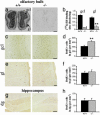Nicotinic receptors regulate the survival of newborn neurons in the adult olfactory bulb
- PMID: 15210938
- PMCID: PMC470758
- DOI: 10.1073/pnas.0403361101
Nicotinic receptors regulate the survival of newborn neurons in the adult olfactory bulb
Abstract
Cholinergic axons and nicotinic receptors are abundant in all layers of the olfactory bulb (OB), the main region of newborn neuron integration in the adult brain. Here, we report that the OB granule cell layer in mice lacking the predominant form of brain high-affinity nicotinic acetylcholine receptors (beta(2)(-/-) mice) displayed nearly 50% more newborn neurons and significantly fewer apoptotic cells than did beta(2)(+/+) mice. Conversely, in vivo chronic nicotine exposure significantly decreased the number of newborn granule cells in beta(2)(+/+) but not beta(2)(-/-) adult mice, confirming that the survival of newborn neurons can be controlled by the activation of beta(2)-containing nicotinic acetylcholine receptors. Unexpectedly, investigating the behavioral consequence of an increased number of granule cells in beta(2)(-/-) mice revealed that these animals have a less robust short-term olfactory memory than their wild-type counterparts. Taken together, these results provide evidence that high-affinity nicotinic receptors are involved in the maturation of adult OB local circuits. They also indicate that an increase in the number of granule cells does not necessarily correlate with better olfactory performance and further highlight the importance of cholinergic afferents for olfactory processing.
Figures





Similar articles
-
Role of the cholinergic system in regulating survival of newborn neurons in the adult mouse dentate gyrus and olfactory bulb.Genes Cells. 2006 Oct;11(10):1145-59. doi: 10.1111/j.1365-2443.2006.01010.x. Genes Cells. 2006. PMID: 16999735
-
Changes in adult olfactory bulb neurogenesis in mice expressing the A30P mutant form of alpha-synuclein.Eur J Neurosci. 2009 Mar;29(5):879-90. doi: 10.1111/j.1460-9568.2009.06641.x. Eur J Neurosci. 2009. PMID: 19291219
-
Alteration of hippocampal cell proliferation in mice lacking the beta 2 subunit of the neuronal nicotinic acetylcholine receptor.Synapse. 2004 Dec 15;54(4):200-6. doi: 10.1002/syn.20081. Synapse. 2004. PMID: 15472930
-
Long-term fate and distribution of newborn cells in the adult mouse olfactory bulb: Influences of olfactory deprivation.Neuroscience. 2006 Aug 11;141(1):443-51. doi: 10.1016/j.neuroscience.2006.03.066. Epub 2006 May 18. Neuroscience. 2006. PMID: 16713121
-
Influence of age on nicotinic cholinergic regulation of blood flow in rat's olfactory bulb and neocortex.J Physiol Sci. 2024 Mar 15;74(1):18. doi: 10.1186/s12576-024-00913-8. J Physiol Sci. 2024. PMID: 38491428 Free PMC article. Review.
Cited by
-
A Novel Vaccine Employing Non-Replicating Rabies Virus Expressing Chimeric SARS-CoV-2 Spike Protein Domains: Functional Inhibition of Viral/Nicotinic Acetylcholine Receptor Complexes.Med Sci Monit. 2020 May 28;26:e926016. doi: 10.12659/MSM.926016. Med Sci Monit. 2020. PMID: 32463026 Free PMC article.
-
Neuronal survival in the brain: neuron type-specific mechanisms.Cell Death Dis. 2017 Mar 2;8(3):e2643. doi: 10.1038/cddis.2017.64. Cell Death Dis. 2017. PMID: 28252642 Free PMC article. Review.
-
Methods to measure olfactory behavior in mice.Curr Protoc Toxicol. 2015 Feb 2;63:11.18.1-11.18.21. doi: 10.1002/0471140856.tx1118s63. Curr Protoc Toxicol. 2015. PMID: 25645244 Free PMC article.
-
Endogenous signaling through alpha7-containing nicotinic receptors promotes maturation and integration of adult-born neurons in the hippocampus.J Neurosci. 2010 Jun 30;30(26):8734-44. doi: 10.1523/JNEUROSCI.0931-10.2010. J Neurosci. 2010. PMID: 20592195 Free PMC article.
-
Inducible and targeted deletion of the ERK5 MAP kinase in adult neurogenic regions impairs adult neurogenesis in the olfactory bulb and several forms of olfactory behavior.PLoS One. 2012;7(11):e49622. doi: 10.1371/journal.pone.0049622. Epub 2012 Nov 21. PLoS One. 2012. PMID: 23185386 Free PMC article.
References
Publication types
MeSH terms
Substances
LinkOut - more resources
Full Text Sources
Other Literature Sources
Medical
Molecular Biology Databases
Miscellaneous

